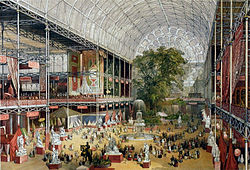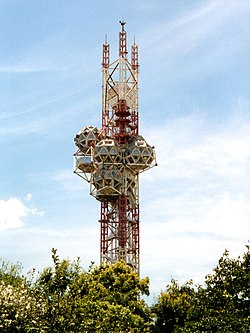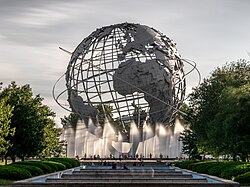| # | Name of exposition | Dates | Area (ha) | Visitors | Participants | Theme |
|---|
| 1 |  Great Exhibition (London) 1851 Great Exhibition (London) 1851 | 1 May – 11 October 1851 | 10.40 | 6,039,195 | 25 | Industry of all Nations |
| 2 |  Exposition Universelle (1855) (Paris) Exposition Universelle (1855) (Paris) | 15 May – 15 November 1855 | 15.20 | 5,162,330 | 28 | Agriculture, Industry and Fine Arts |
| 3 |  1862 International Exhibition (London) 1862 International Exhibition (London) | 1 May – 1 November 1862 | 11 | 6,096,617 | 39 | Industry and Art |
| 4 |  Exposition Universelle (1867) (Paris) Exposition Universelle (1867) (Paris) | 1 April – 3 November 1867 | 68.70 | 15,000,000 | 42 | Agriculture, Industry and Fine Arts |
| 5 |  Weltausstellung 1873 Wien (Vienna) Weltausstellung 1873 Wien (Vienna) | 1 May – 31 October 1873 | 233 | 7,255,000 | 35 | Culture and Education |
| 6 |  Centennial Exposition (Philadelphia) 1876 Centennial Exposition (Philadelphia) 1876 | 10 May – 10 November 1876 | 115 | 10,000,000 | 35 | Arts, Manufactures and Products of the Soil and Mine |
| 7 |  Exposition Universelle (1878) (Paris) Exposition Universelle (1878) (Paris) | 20 May – 10 November 1878 | 75 | 16,156,626 | 35 | New Technologies |
| 8 |  Melbourne International Exhibition (1880) Melbourne International Exhibition (1880) | 1 October 1880 – 30 April 1881 | 25 | 1,330,000 | 33 | Arts, Manufactures and Agricultural and Industrial Products of all Nations |
| 9 |  Exposición Universal de Barcelona (1888) Exposición Universal de Barcelona (1888) | 8 April – 10 December 1888 | 46.50 | 2,300,000 | 30 | Fine and Industrial Art |
| 10 |  Exposition Universelle (1889) (Paris) Exposition Universelle (1889) (Paris) | 5 May – 31 October 1889 | 96 | 32,250,297 | 35 | Celebration of the centenary of the French revolution |
| 11 |  World's Columbian Exposition (Chicago) 1893 World's Columbian Exposition (Chicago) 1893 | 1 May – 3 October 1893 | 290 | 27,500,000 | 19 | Fourth centenary of the discovery of America |
| 12 |  Brussels International (1897) (Brussels) Brussels International (1897) (Brussels) | 10 May – 8 November 1897 | 36 | 6,000,000 | 27 | Modern Life |
| 13 |  Exposition Universelle (1900) (Paris) Exposition Universelle (1900) (Paris) | 15 April – 12 November 1900 | 120 | 50,860,801 | 40 | 19th century: an overview |
| 14 |  Louisiana Purchase Exposition (St. Louis) 1904 Louisiana Purchase Exposition (St. Louis) 1904 | 30 April – 1 December 1904 | 500 | 19,694,855 | 60 | Celebration of the centennial of the Louisiana Purchase |
| 15 |  Liège International (1905) Liège International (1905) | 27 April – 6 November 1905 | 70 | 7,000,000 | 35 | Commemoration of the 75th anniversary of independence |
| 16 |  Milan International (1906) Milan International (1906) | 28 April – 11 November 1906 | 100 | 4,012,776 | 40 | Transportation |
| 17 |  Brussels International 1910 Brussels International 1910 | 23 April – 7 November 1910 | 30 | 13,000,000 | 26 | Works of Art and Science, Agricultural and Industrial Products of All Nations |
| 18 |  Exposition universelle et internationale (1913) (Ghent) Exposition universelle et internationale (1913) (Ghent) | 26 April – 3 November 1913 | 130 | 9,503,419 | 24 | Peace, Industry and Art |
| 19 |  Panama–California Exposition (San Diego) 1915-1917 Panama–California Exposition (San Diego) 1915-1917 | 1 January 1915 – 1 January 1917 | 260 | 3,747,916 | 24 | Celebrating the opening of the Panama Canal |
| 20 |  Panama–Pacific International Exposition (San Francisco) 1915 Panama–Pacific International Exposition (San Francisco) 1915 | 20 February – 4 December 1915 | 254 | 18,876,438 | 41 | Celebrating the opening of the Panama Canal |
| 21 |  1929 Barcelona International Exposition 1929 Barcelona International Exposition | 20 May 1929 – 15 January 1930 | 118 | 5,800,000 | 29 | Industry, Art and Sport |
| 22 |  Century of Progress (Chicago) 1933-1934 Century of Progress (Chicago) 1933-1934 | 27 May 1933 – 31 October 1934 | 170 | 38,872,000 | 21 | The independence among Industry and scientific research. |
| 23 |  Brussels International Exposition (1935) Brussels International Exposition (1935) | 27 April – 3 November 1935 | 152 | 20,000,000 | 25 | Transport |
| 24 |  Exposition Internationale des Arts et Techniques dans la Vie Moderne (Paris) 1937 Exposition Internationale des Arts et Techniques dans la Vie Moderne (Paris) 1937 | 25 May – 25 November 1937 | 104 | 31,040,955 | 35 | Arts and technology in modern life |
| 25 |  1939 New York World's Fair 1939 New York World's Fair | 30 April 1939 – 27 October 1940 | 500 | 45,000,000 | 54 | Building the World of Tomorrow |
| 26 |  Exposition internationale du bicentenaire de Port-au-Prince 1949-1950 Exposition internationale du bicentenaire de Port-au-Prince 1949-1950 | 8 December 1949 – 8 June 1950 | 30 | 250,000 | 18 | The festival of Peace |
| 27 |  Expo '58 (Brussels) Expo '58 (Brussels) | 17 April – 19 October 1958 | 200 | 41,454,412 | 39 | A World View: A New Humanism |
| 28 |  Century 21 Exposition (Seattle) Century 21 Exposition (Seattle) | 21 April – 21 October 1962 | 30 | 9,000,000 | 49 | Man in the Space Age |
| 29 |  Expo 67 (Montreal) Expo 67 (Montreal) | 28 April – 29 October 1967 | 400 | 50,306,648 | 62 | Man and his World |
| 30 |  Expo '70 (Osaka) Expo '70 (Osaka) | 15 March – 13 September 1970 | 330 | 64,218,770 | 67 | Progress and Harmony for Mankind |
| 31 |  Seville Expo '92 Seville Expo '92 | 20 April – 12 October 1992 | 215 | 41,814,571 | 108 | The Age of Discovery |
| 32 |  Expo 2000 (Hanover) Expo 2000 (Hanover) | 1 June – 31 October 2000 | 160 | 18,100,000 | 174 | Humankind – Nature – Technology |
| 33 |  Expo 2005 (Nagoya) Expo 2005 (Nagoya) | 25 March – 25 September 2005 | 173 | 22,049,544 | 121 | Nature's Wisdom |
| 34 |  Expo 2010 (Shanghai) Expo 2010 (Shanghai) | 1 May – 31 October 2010 | 523 | 73,085,000 | 100 | Better City, Better Life |
| 35 |  Expo 2015 (Milan) Expo 2015 (Milan) | 1 May – 31 October 2015 | 110 | 22,200,000 | 139 | Feeding the Planet, Energy for Life |
| 36 |  Expo 2020 (Dubai) Expo 2020 (Dubai) | 1 October 2021 – 31 March 2022 | 438 | 24,102,967 | 200 | Connecting Minds, Creating the Future |
| 37 |  Expo 2025 (Osaka) Expo 2025 (Osaka) | 13 April – 13 October 2025 | 155 | 25,578,986 | 165 | Designing Future Society for Our Lives |
| 38 |  Expo 2030 (Riyadh) Expo 2030 (Riyadh) | 1 October 2030 – 31 March 2031 | 600 | | | Foresight for Tomorrow |
















